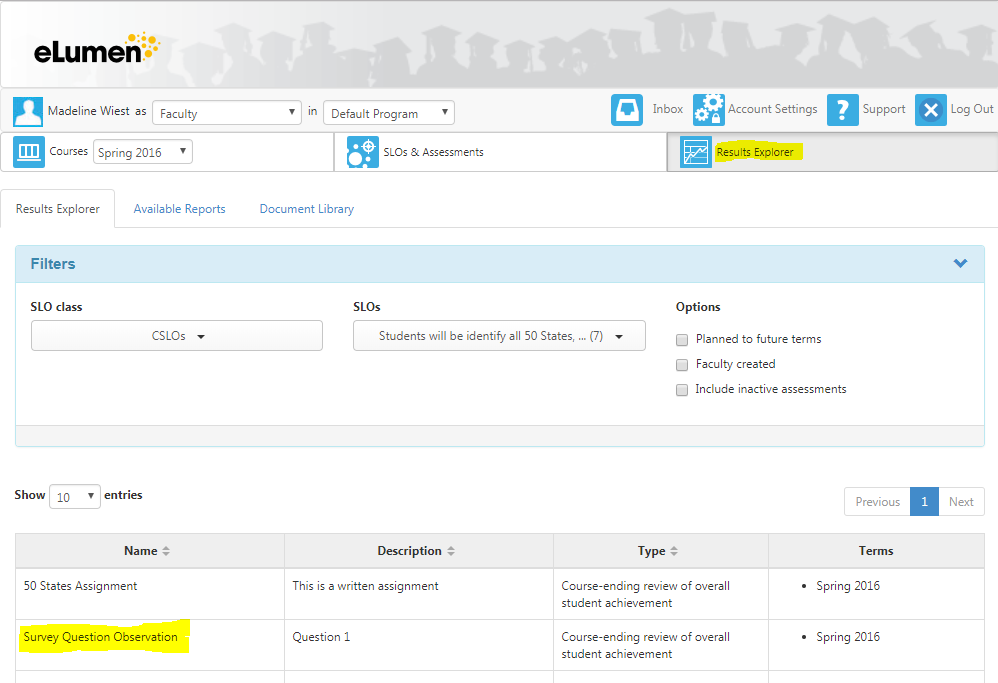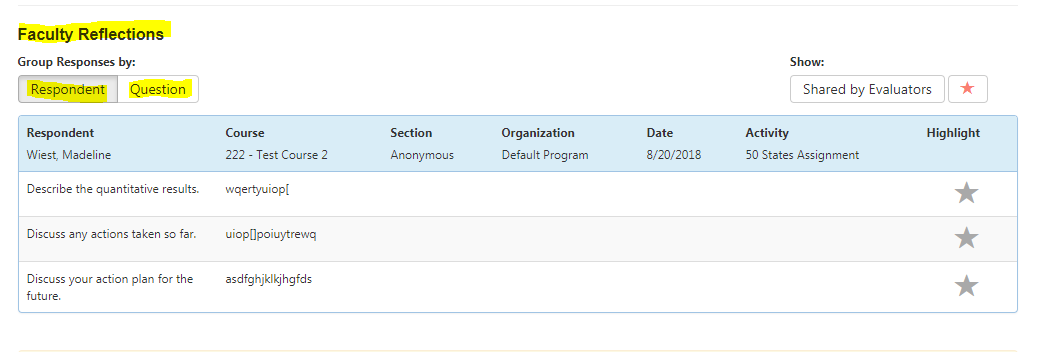- Las Positas College
- Student Learning Outcomes
- eLumen Instructions: Student Services
Student Learning Outcomes
eLumen Instructions for Student Services
- Creating an SAO
- Creating a setting
- Adding an assessment
- Entering assessment results
- Obtaining assessment data
- Viewing Reflections
- Creating a new version of an SAO
- Deactivating or removing an SAO
- Mapping SAOs
Logging In
If you are logging into eLumen for the first time, access the site at https://laspositas.elumenapp.com using Chrome (Chrome is the preferred browser for eLumen), and click Forgot Password. Enter your username, which is the first letter of your first name, followed by your last name (example: gwashington). Enter your college email address, then click Request. Check your college email account, and follow the instructions to log in.
Creating an SAO
Only the coordinator can create SAOs. To begin, make sure your role of coordinator is showing in the drop-down next to your name, and next to that, make sure your Student Services area is showing.
- Click SLOs & Assessments.

- Click Add CSLO (the "C" stands for context).

- Type in your SAO. If you'd like, you can begin with "Upon completion of the student's
interaction with (name of the Student Services area), the student should be able to..."
Leave "Short Name" and "Code" BLANK. Under "Performance" please enter the default percentage of 70%. When finished, click Save.
- Answer the question about why the outcome needs to be created. Make sure you include
your name and the name of the Student Services area. Click Save and Continue.

- In the second drop-down, choose Core ISLOs.
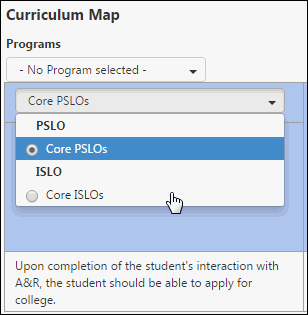
- Here is where you will map your new context SAO to an institutional outcome(s). All
five of the colleges institutional outcomes will show up, along with their categories,
across the top of the matrix. Since the list is rather lengthy, you can click the
right arrow to move in that direction.
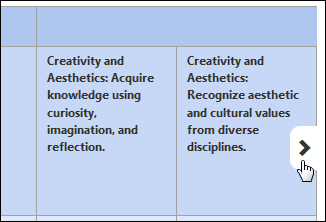
You can also just show one institutional outcome at a time by clicking the drop-down for All Categories and choosing one of the five ISLOs.
- Clicking a box for an SAO will map it to the corresponding ISLO and one of its categories.
You can map an SAO to multiple ISLOs if desired.
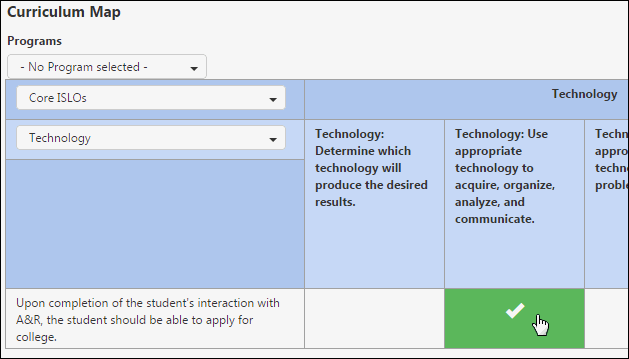
- Click Submit at the bottom. Your new SAO will not show up right away; it will have to be approved by the SLO Committee Chair first. Once approved, it will appear. If you want to see it when it appears, click SLOs & Assessments.
Creating a Setting
A setting is the Student Services equivalent in eLumen to a course section (a context is the Student Services equivalent to a course). You will need to create a setting in order to add an assessment to it.
To begin, make sure your role of Coordinator is showing in the drop-down next to your name, and next to that, make sure your area is showing.
![]()
- Click Org Management.
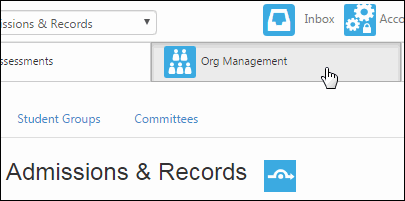
- Under Type, choose Context. Click Add Setting.

- Type in a Setting name that reflects what you will be assessing, and choose the term
(typically the current term).

If all of the students you are assessing fall into a specific group(s), click Assign Attributes, then click the attributes you want, and Close. If there is an attribute not on the list you need, contact the system administrator. You can also assign a student roster or student group as a roster if you want. Otherwise, leave those alone.
Click Assign Evaluators. Search for your name, click it, then Close.
- Click Save. Your setting has been added.

Adding an Assessment
- Choose Faculty from the drop-down next to your name, and make sure your area is showing
in the drop-down next to it. If you don't see Faculty, you might need to log out of
eLumen, then log back in.

- Choose the semester from the drop-down next to Courses. You will see a list of any
settings you created.

- Locate your desired setting, and click Add Assessment. (If your assessment has already
been created, you can click Find Assessment, choose it from a list, then add it to
your setting.)

For Select the Assessment Type, choose COLLECTIVE STUDENT SCORE ENTRY. This allows you to aggregate your scoring.
Add an assessment name, description, then choose an assessment type. The last two assessment types in the drop-down are for Student Services only. Choose one of them.
DO NOT click the link to Add Reflections Template. The LPC Reflections is set as the default.
OPTIONAL: You can upload an assessment guide, such as student instructions.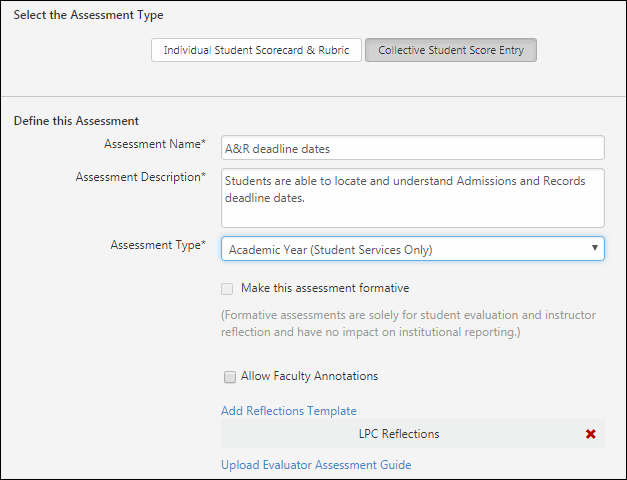
Name and describe the activity for your assessment.
For Assessment Scale, it is recommended that you leave LPC Generic Rubric selected.
Make sure Outcomes-Oriented is chosen for Rubric Type.
Unless you will be scoring multiple SLOs with the same assessment, you can leave the Number of SLOs field at 1.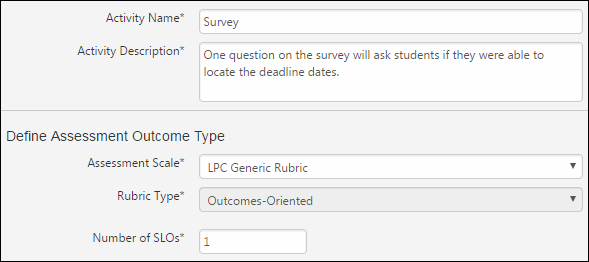
Click Generate Rubric Template.
- Attach the SAO to the rubric by clicking Link SAO.

- Click your desired SAO on the left, then click Close.
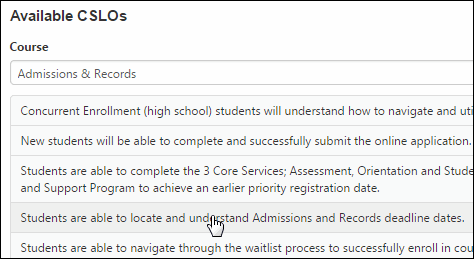
If you want, you can change the "performance descriptors" in each level of the LPC Generic Rubric. Simply click in a level, delete the word(s) that is there, and type in your description of what students need to achieve to reach that level. Otherwise, leave the descriptors alone. If you chose to use a different scale, you will have to change the descriptors for each level.
You can ignore the part about DLA Mapping. - Click Save.

Entering Assessment Results
- Make sure you are in the setting and semester you want to score. If not, select the
semester from the drop-down list next to your name, and scroll to the setting. To
the right of the assessment is an icon under the column called Scorecard. Click it.

- Input your collective scores into the appropriate boxes, then click Save and Continue
to Reflection.

- Fill out the text fields in the reflection, and click Submit. You are finished!
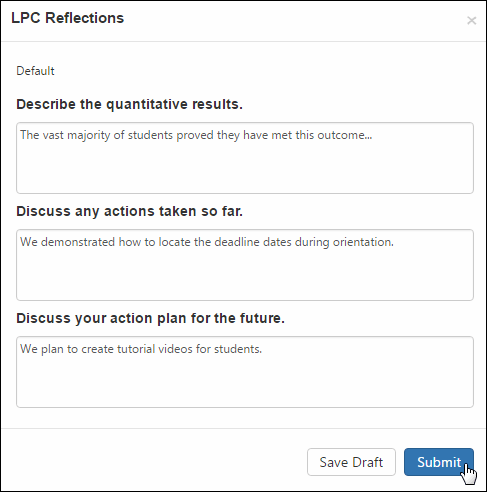
Obtaining Assessment Data
- Make sure you are in as the coordinator. Click Reports.

- Click SAO Performance - By Division, Course, CSLO.

- Choose the terms you want to include. Click Context. The default report format is
PDF. Click Generate Report.

- You will be taken to the Document Library, where your report will be available for
download. The report might take a minute or so to generate.

Viewing Reflections
In order to view previous reflections select the Results Explorer on the top right hand side.
Select the assessment for which you would like to view the reflection from the list below.
Then select Table View.
You will then scroll down to the bottom of the page to view Faculty Reflections. You can view reflections by either respondent or questions.
Student Learning Outcomes Committee
Committee Meeting Schedule
Monthly on the 2nd & 4th Mondays
from 2:30 - 4:30 p.m. in 21147
For more information please contact:
John Rosen
SLO Committee Chair
(925) 424-1296
jrosen@laspositascollege.edu
Alaina Osuka
Curriculum & SLO Specialist
(925) 424-1106
aosuka@laspositascollege.edu



